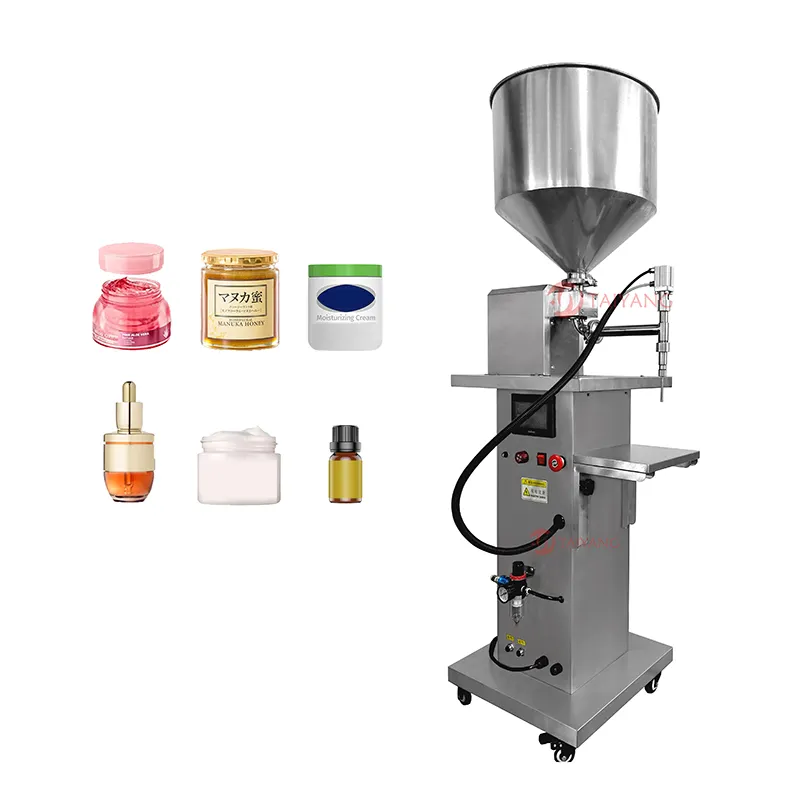Everything You Need to Know About Paste Filling Machines
2024-10-25
In industries like food, cosmetics, pharmaceuticals, and chemicals, packaging products efficiently and accurately is crucial for maintaining quality and meeting production demands. Paste filling machines are essential in this process, especially for handling thick, semi-liquid products like creams, sauces, gels, and pastes. These machines offer precise control, reduce wastage, and increase productivity, making them a must-have for many manufacturers. In this blog, we'll explore what paste filling machines are, their types, benefits, and how to choose the right one for your needs.
---
What is a Paste Filling Machine?
A paste filling machine is specialized equipment designed to fill containers with semi-liquid or viscous products. These machines are widely used in industries where thick substances need to be dispensed into jars, bottles, tubes, or pouches. Whether it's food products like peanut butter, jams, or non-food items like toothpaste, lotions, or chemical pastes, these machines ensure consistent and efficient filling.
Key Features of Paste Filling Machines
- Precision: Ensures accurate filling volumes, reducing waste and improving product consistency.
- Adjustability: Many paste filling machines allow users to adjust the filling speed, volume, and temperature settings to accommodate different product types and packaging sizes.
- Hygiene: Machines designed for industries like food and pharmaceuticals feature stainless steel construction and easy-to-clean parts, ensuring sanitary operations.
- Automation: From manual and semi-automatic to fully automated systems, paste filling machines can cater to both small-scale and large-scale production needs.

Types of Paste Filling Machines
Different industries and product types require varying degrees of sophistication and automation. Here are the main types of paste filling machines:
1. Manual Paste Filling Machines
Manual paste filling machines are simple, hand-operated devices designed for small-scale production. They are affordable and suitable for small businesses or startups. Though limited in speed and capacity, they provide reliable and consistent filling for low-volume operations.
- Advantages: Cost-effective, easy to use, and portable.
- Best for: Small businesses, home-based production, and companies with limited output requirements.
2. Semi-Automatic Paste Filling Machines
Semi-automatic machines offer a blend of manual and automated functions. Operators typically control the filling process by pressing a foot pedal or activating a switch, while the machine handles the actual filling. These machines are versatile and can be used for a wide range of products.
- Advantages: Higher filling accuracy, more control over the process, and increased productivity compared to manual machines.
- Best for: Medium-sized businesses looking for efficiency without the cost of fully automated systems.
3. Fully Automatic Paste Filling Machines
Fully automatic paste filling machines are designed for high-volume production lines. They automatically handle all aspects of the filling process, from feeding containers to dispensing the product and sealing. These machines are equipped with advanced features like multi-head filling, conveyor belts, and precise dosing systems.
- Advantages: High-speed filling, minimal operator intervention, and superior accuracy.
- Best for: Large-scale operations that require fast, continuous filling with minimal downtime.
4. Piston Paste Filling Machines
Piston filling machines are widely used for paste products due to their ability to handle thick, viscous substances efficiently. They operate using a piston that draws the paste into the machine and then dispenses it into the container at a set volume.
- Advantages: Ideal for high-viscosity products, highly accurate, and capable of handling both large and small containers.
- Best for: Industries requiring precise filling for thick substances like sauces, adhesives, or creams.
5. Gravity-Based Paste Filling Machines
Gravity-based filling machines use the force of gravity to fill containers. While commonly used for liquids, some models are capable of handling semi-liquids and low-viscosity pastes. These machines are best suited for free-flowing products that don't require much pressure to fill.
- Advantages: Simple operation, cost-effective, and low maintenance.
- Best for: Products that are more liquid-like in consistency or thin pastes.
---
Benefits of Using Paste Filling Machines
Investing in a paste filling machine offers numerous advantages for businesses:
1. Improved Efficiency
Manual filling can be slow and inconsistent, especially for thick products. Paste filling machines significantly increase the speed and consistency of the process, ensuring uniform product distribution and reducing production time.
2. Accuracy and Precision
Paste filling machines ensure that each container receives the exact amount of product, minimizing wastage and ensuring compliance with packaging regulations. This precision also reduces product giveaway, saving costs in the long run.
3. Versatility
Many paste filling machines can handle a wide variety of products, from food items to industrial pastes. Adjustable settings make it easy to switch between different product types and container sizes, making these machines incredibly versatile.
4. Hygiene and Cleanliness
For industries like food and pharmaceuticals, maintaining strict hygiene standards is critical. Paste filling machines are designed with easy-to-clean components and stainless steel construction, reducing the risk of contamination and ensuring compliance with health standards.
5. Scalability
Whether you're running a small business or a large production facility, paste filling machines offer scalable solutions. Start with a manual or semi-automatic machine and upgrade to a fully automated system as your business grows.
---
How to Choose the Right Paste Filling Machine
When selecting a paste filling machine, consider the following factors:
1. Type of Paste
The viscosity and texture of the paste will determine the type of machine you need. Thicker products, like peanut butter or silicone sealant, require a piston filling machine, while thinner pastes may work with gravity-fed systems.
2. Production Volume
For small-scale operations, a manual or semi-automatic machine may suffice. However, for larger production lines, fully automated systems are essential to meet demand.
3. Container Size and Shape
The size and shape of the container you’re filling will impact the machine’s compatibility. Ensure the machine can adjust to accommodate your specific packaging requirements.
4. Budget
Paste filling machines come in a range of prices, depending on their level of automation and functionality. Small businesses may opt for a more affordable manual or semi-automatic machine, while large factories may invest in high-end, fully automated systems.
---
Final Thoughts
Paste filling machines are essential equipment for industries that handle semi-liquid products. By ensuring accuracy, efficiency, and hygiene, these machines play a vital role in the packaging process, helping businesses increase productivity and reduce costs. Whether you're a small-scale producer or managing a large factory, choosing the right paste filling machine will set your operation up for success.


